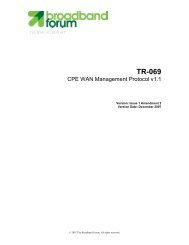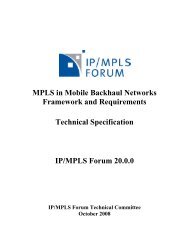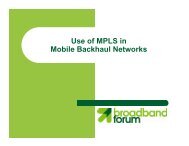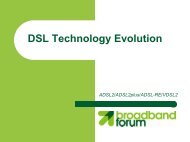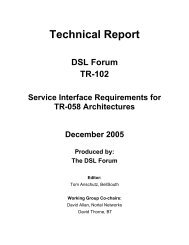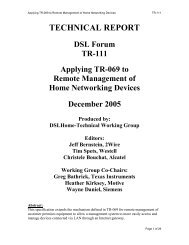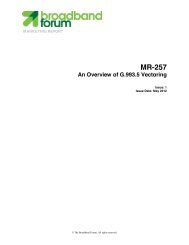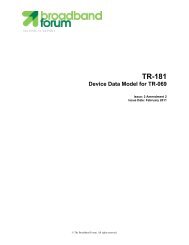Broadband Forum - Remote Management Work
Broadband Forum - Remote Management Work
Broadband Forum - Remote Management Work
Create successful ePaper yourself
Turn your PDF publications into a flip-book with our unique Google optimized e-Paper software.
<strong>Broadband</strong> <strong>Forum</strong> - <strong>Remote</strong><br />
<strong>Management</strong> <strong>Work</strong>
Why Standardize <strong>Management</strong><br />
Protocols?<br />
2
OSS/BSS<br />
WT-131, WT-131, WT-132:<br />
WT-132:<br />
ACS ACS Northbound<br />
Northbound<br />
Interface<br />
Interface<br />
<strong>Broadband</strong>Home<br />
<strong>Remote</strong> <strong>Management</strong> Framework<br />
Policy<br />
Auto-Configuration<br />
Server<br />
(ACS)<br />
Call<br />
Center<br />
New! New! TR-142<br />
TR-142<br />
TR-069 TR-069 Framework Framework for<br />
for<br />
PON<br />
PON<br />
TR-069 TR-069 CPE CPE WAN<br />
WAN<br />
<strong>Management</strong> <strong>Management</strong> Protocol<br />
Protocol<br />
New! New! TR-143:<br />
TR-143:<br />
Throughput<br />
Throughput<br />
Performance Performance Testing<br />
Testing<br />
Residential Gateway<br />
TR-98 TR-98 Internet Internet Gateway<br />
Gateway<br />
Device Device (IGD)<br />
(IGD)<br />
TR-111: NAT Traversal<br />
TR-068, TR-068, TR-124 TR-124 RG<br />
RG<br />
Femto Cell<br />
IP STB<br />
TR-196 Femto Cell<br />
New! TR-135: STB<br />
TR-104: TR-104: VoIP<br />
VoIP<br />
TR-122: TR-122: Voice Voice ATA<br />
ATA<br />
TR-140: TR-140: Storage<br />
Storage<br />
TR-064, TR-064, TR-133:<br />
TR-133:<br />
LAN-Side LAN-Side CPE CPE Mgmt<br />
Mgmt<br />
TR-106: TR-106: Common Common Data<br />
Data<br />
Model Model Template<br />
Template<br />
HPNA G.hn Wireless<br />
MoCA Ethernet HomePlug<br />
Storage<br />
VoIP<br />
Voice ATA<br />
PC
4<br />
Summary of TR-069 (CWMP) Benefits<br />
� Profitable and seamless service deployment<br />
– Reduce costs<br />
– Enable services<br />
– Improve customer experience<br />
� Higher layer protocol – network (and device) agnostic<br />
� Robust functionality<br />
– Granular device and service control<br />
– Flexible, policy-based management<br />
� Well-defined extensibility mechanisms<br />
– New devices and services<br />
– Vendor differentiation<br />
� Standard web technologies<br />
– Scalable<br />
– Secure<br />
– Widespread<br />
� Applicable to full range of devices on home network<br />
– Annexes F (device/gateway association) and G (NAT traversal)
5<br />
TR-069: CWMP Protocol<br />
ACS Discovery<br />
Auto-Configuration<br />
Server (ACS)<br />
CWMP Connection Initiation<br />
� Bootstrap – first connect to network<br />
� Requested by ACS – Scheduled or<br />
immediately<br />
� Asynchronous Notifications<br />
> Active – as soon as value changes<br />
> Passive – report value next inform<br />
Bi-directional Communication<br />
Connection<br />
Request<br />
Inform<br />
Managed<br />
Device<br />
Device Control<br />
� Get, Set Parameter Values and<br />
Attributes<br />
� Add, Delete Objects<br />
� Reboot, Reset to Factory Defaults<br />
� Initiate Firmware Download<br />
� Initiate diagnostic tests
Applying CWMP (TR-069) to<br />
Residential Gateway<br />
� <strong>Management</strong> Functions<br />
– Auto Configuration<br />
– Service Provisioning<br />
– Firmware <strong>Management</strong><br />
– Diagnostics<br />
– Fault and Performance Monitoring<br />
� Interdependent TRs<br />
– TR-098: Internet Gateway Device (IGD) Data Model<br />
– TR-106: Data model - defines general template for data model definition<br />
– TR-122: Base Requirements for Consumer-Oriented Analog Terminal Adapter<br />
Functionality<br />
– TR-124: Functional Requirements for <strong>Broadband</strong> Residential Gateway Devices<br />
– TR-142: Framework for TR-069 enabled PON devices<br />
– TR-143: Enabling Network Throughput Performance Tests and Statistical<br />
Monitoring
Applying CWMP (TR-069) to Home<br />
Network End Device<br />
� <strong>Management</strong> Functions<br />
– Auto Configuration<br />
– Service Provisioning<br />
– Firmware <strong>Management</strong><br />
– Diagnostics<br />
– Fault and Performance Monitoring<br />
� Interdependent TRs<br />
– TR-064: LAN-Side DSL CPE Configuration<br />
– TR-068: Base Requirements for an ADSL Modem with Routing<br />
– TR-104: VoIP Provisioning data model<br />
– TR-111: Applying TR-069 to <strong>Remote</strong> <strong>Management</strong> of Home<br />
Networking Devices<br />
– TR-135: STB Data Model supporting IPTV<br />
– TR-140: Storage Data Model<br />
– TR-143: Enabling Network Throughput Performance Tests and<br />
Statistical Monitoring
ACS<br />
8<br />
Applying CWMP to Home Network End<br />
Device<br />
Connection Request<br />
(TCP)<br />
STUN Binding Response<br />
Connection Request (UDP)<br />
Inform (TCP)<br />
Annex F – Device/Gateway Association<br />
� End Device and Gateway exchange<br />
DeviceID via DHCP<br />
> Independent of device address assignment<br />
� Populate relevant objects in data model<br />
> ManagedDevices table in GW<br />
> GatewayInfo object in end device<br />
> ACS can perform optional cross-check<br />
STUN – Simple Traversal of UDP through<br />
NATs (RFC 3489)<br />
Gateway<br />
DHCP Discover/Request/ Inform w/<br />
Device ID<br />
DHCP Offer/ACK with GW ID<br />
STUN Binding Request<br />
End Device<br />
Inform (TCP)<br />
Annex G – NAT traversal for ConnectionRequest<br />
– ACS enables STUN client on device<br />
– Device creates STUN binding with STUN server<br />
� CPE uses STUN protocol to determine NAT type<br />
and public address and communicates to STUN<br />
server<br />
� Uses STUN to maintain UDP binding through NAT<br />
gateway<br />
– ACS sends UDP ConnectionRequest to address<br />
communicated to STUN server<br />
– CPE responds w/ TCP Inform
Supporting and/or Building on CWMP<br />
� WT-123: TR-069 Conformance and Interoperability<br />
Test Plans<br />
� WT-131: ACS Northbound Interface Requirements<br />
� WT-148: CWMP Scalability Extensions<br />
� WT-157: Component objects for CWMP<br />
� WT-196: Femto Access Point Service Data Model<br />
� PD-174: <strong>Management</strong> of Non TR-069 Devices<br />
� PD-193: IPv6 Updates to TR-069 Related TRs<br />
� PD-194: Software Module <strong>Management</strong> using TR-069<br />
� PD-199: TR-069 Bulk <strong>Management</strong>
Service Support<br />
� Features<br />
– Subscriber calls Service Provider call<br />
center to report device problem<br />
– Through the ACS, CSR can query<br />
device settings<br />
� CSR notes that firmware out of date,<br />
contains known bug<br />
� Requests ACS to initiate file<br />
download/upgrade<br />
– RGW reports to ACS when download<br />
complete; ACS indicates results to Help<br />
Desk<br />
� ACS could also change<br />
configuration settings as<br />
appropriate<br />
� Firmware upgrades could also be<br />
managed proactively<br />
� Benefits<br />
– Reduces call center escalation costs<br />
– Reduces AHT, increases FCR<br />
– Streamlines CSR processes<br />
– Reduces RMA, equipment upgrade<br />
costs<br />
– Enables new device capabilities<br />
10<br />
�<br />
Device<br />
issue reported<br />
Subscriber<br />
Help Desk<br />
Use Case: Device Troubleshooting<br />
�<br />
�<br />
Settings<br />
queried &<br />
analyzed<br />
FW Result Indication<br />
RGW<br />
�<br />
New Firmware Download Requested<br />
�<br />
FW<br />
Download<br />
ACS/<br />
FileServer
11<br />
Service Monitoring<br />
� Performance Monitoring<br />
– Service Provider enables monitoring for<br />
subset of STBs<br />
– Determines which statistics to collect<br />
and report interval<br />
– Adjust device configuration as<br />
appropriate<br />
� IGMP<br />
� QoS<br />
� May also require adjustment to other<br />
network/IPTV delivery systems<br />
� Benefits<br />
– Service provider control over statistics<br />
collected<br />
� Focus on key metrics, amount of data,<br />
reporting traffic<br />
– Proactive discovery of service issues<br />
– More intelligent network planning and<br />
ongoing adjustment<br />
�<br />
Use Case: IPTV Service Monitoring<br />
Monitoring<br />
Campaign<br />
�<br />
Enable Stats<br />
Reporting<br />
<strong>Management</strong> System<br />
Subscribers<br />
NMS, EMS<br />
�<br />
Data Correlated &<br />
Analyzed, Problem<br />
Identified<br />
�<br />
Configuration<br />
Update<br />
�<br />
Perf Data<br />
to NMS<br />
�<br />
Stats Reports
SDOs Using/referencing TR-069 CWMP for<br />
Service Provider <strong>Management</strong><br />
� 3GPP<br />
� ATIS IIF<br />
� DVB (Digital Video Broadcast) IPI<br />
� ETSI TS 183065<br />
� Femto <strong>Forum</strong><br />
� FSAN<br />
� Home Gateway Initiative (HGI)<br />
� ITU-T SG HN / IPTV<br />
� Open IPTV <strong>Forum</strong><br />
� Universal Plug and Play (UPnP)<br />
� WiMax <strong>Forum</strong>
Relationship of TR-069 to Other<br />
Home Network <strong>Management</strong><br />
Protocols<br />
13
WAN Versus LAN Protocols<br />
14
WAN versus LAN protocols<br />
Internet<br />
198.168.1.1<br />
Gateway<br />
198.168.1.2<br />
15<br />
Home Network #1<br />
…<br />
198.168.1.3<br />
<strong>Remote</strong> <strong>Management</strong> System(s)<br />
…<br />
WAN<br />
LAN
Proxy <strong>Management</strong><br />
Internet<br />
P<br />
198.168.1.1<br />
Gateway<br />
198.168.1.2<br />
16<br />
Home Network #1<br />
…<br />
198.168.1.3<br />
<strong>Remote</strong> <strong>Management</strong> System(s)<br />
…<br />
WAN<br />
LAN<br />
P Proxy
Home Network <strong>Management</strong> Protocols<br />
Summary<br />
17
UPnP As A LAN <strong>Management</strong> Protocol<br />
– Basis for TR-064<br />
18
Other Relevant Home Network Protocols<br />
Utilized in TRs or WTs<br />
DHCP the DHCP server knows a lot about the home network so, if it’s remotely<br />
managed, it can make that information available to the RMS<br />
Layer 2<br />
mediaspecific<br />
Layer 2 interfaces embedded into remotely managed devices, e.g. WiFi<br />
access points, are typically aware of associated devices, and may also be<br />
able to provide statistics or even perform diagnostic tests<br />
LLTD Link Layer Topology Discovery; part of Windows Rally, it allows discovery<br />
of home network topology and related device-specific information; could<br />
be useful if a remotely managed device includes an LLTD mapper<br />
LLDP Link Layer Discovery Protocol; standardized as IEEE 802.1AB so<br />
potentially attractive, but currently seems more aimed at the access<br />
network and the enterprise<br />
Multicast<br />
discovery<br />
mDNS/DNS-SD and SSDP both provide Multicast announcement of<br />
services offered by home network devices; broadly speaking,<br />
mDNS/DNS-SD is the Apple approach, whereas SSDP is the UPnP<br />
discovery protocol<br />
Proprietary There are many proprietary protocols; if a remotely managed device<br />
supports such a protocol it can use it to discover and pass information to<br />
the RMS<br />
19
Summary<br />
� <strong>Broadband</strong>Home specifications establishes a framework for<br />
– Auto Configuration<br />
– Service Provisioning<br />
– Firmware <strong>Management</strong><br />
– Diagnostics<br />
– Fault and Performance Monitoring<br />
� <strong>Broadband</strong>Suite provides WAN management and LAN<br />
management of<br />
– Gateways<br />
– Home networked end devices<br />
� Leverages existing standards<br />
� Focused on improving customer experience across all<br />
managed services
Questions?<br />
<strong>Work</strong>ing Together<br />
www.broadband-forum.org



